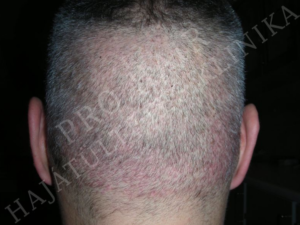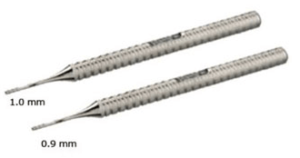What is FUE Hair Transplant ?
FUE (Follicular Unit Extraction) is an innovative method of hair transplantation. Appeared in the 2000s, it is the most modern and most advanced hair implant technique.

Having many advantages over the old method, FUT (Follicular Unit Transplant), it allows to perform hair grafts without pain, without linear scarring, with a natural and durable result and rapid recovery.
In addition, the FUE is suitable for both men and women.
The Benefits of FUE Hair Transplant in Budapest
Natural and sustainable result
Non-invasive and painless
No linear scar
Short recovery
Donor Area in a FUE

The follicular units are removed from the donor area of the patient using an instrument to extract the follicular unit precisely without damaging it.
For the FUE hair transplantation, the donor zone is located at the patient’s crown, in the occipital zone (above the neck), between the two ears. The hair in the donor area is insensitive to dihydrotestosterone (DHT) and will remain so. Thus, the implanted hair will never fall.
Cost of a FUE Hair Transplant in Budapest, Hungary

Save thousands on the price of your FUE hair transplant in the UK or elsewhere in Central Europe. You can find more information on the price of our FUE by clicking on this link.
Evolution of the FUE

FUE was first described in 2002. In an article published by two surgeons;Dr. William Rassman andDr. Robert Bernstein. This one described the use of a punch to extract the grafts individually from the donor area of the patient. These grafts were then implanted successfully in the recipient area of the patient.
From the beginning, the big advantage of the FUE was to minimize the scars on the donor area of the patient. Indeed, while the FUT requires incisions to extract the grafts, the FUE is performed without any linear incisions in the donor area.
Since then, the FUE technique has spread rapidly and evolved. Notably, by the high demand of patients for a method of hair restoration without a linear scar. Today, FUE is used in 40% of hair transplants. This allows the extraction and placement of 1’000 grafts per day manually.
To facilitate the surgeon’s work and increase the number of implanted grafts per session, some clinics now use robots. For reasons of quality of results, we prefer to perform hair transplants manually.
FUE Candidate
A FUE hair transplant is just as good for a man as for a woman. Indeed, we also offer FUE without shaving hair.
This technique of capillary implantation is well suited to people who want to keep short hair in the back or shave 3 mm because it leaves no visible scar.
Preparing for a FUE Hair Transplant

Before your FUE hair transplant in Budapest Hungary, a blood test must be done. This can be done the day before the operation directly after your arrival in Budapest or otherwise at your doctor’s office.
A week before your capillary intervention in Budapest, it will be necessary to stop doing or taking the following things: aspirin, sport, sauna, vitamins, dietary supplements, caffeine, tea and alcohol.
FUE Procedure in Budapest Hungary

The FUE method consists of individually sampling the follicular units or grafts in the donor zone and then implanting it in the recipient, balding or bald zone.
Length of the FUE
The length of an FUE will depend on a number of grafts to implement. Usually, 1’000 grafts are implanted per day. For example, if 3,000 follicular units had to be implanted, the hair transplant will take place over 3 days.
Hair Preparation
The surgeon traces with surgical marker the area of the scalp that you want to redensify. He will then do a hair analysis to determine how he will distribute the grafted hair to cover the bald area optimally.
A calculation (densitometry) is performed in the donor area, to determine the number of available grafts. For a homogeneous result and to respect the evolution of baldness, we do not take more than 30% of available hair.
To finish the preparation, the surgeon prepares the hair. Here two solutions are possible.
If you have chosen a classic FUE, the surgeon shaves all the hair to a length of 2mm.
If you have chosen a non-shave FUE, the surgeon does not shave the patient’s skull, but cuts only the hair used for implantation. To do so, it is necessary to present the day of the intervention with a length of hair of at least 5 cm.
Anesthesia for a FUE
FUE is performed under local anesthesia only. Slight sedation may also be administered. Local anesthesia is performed on the donor area, at the back of the head, and on the recipient area, the bald area. With anesthesia, the patient will not feel any pain throughout the procedure.
Grafting Grafts
The follicular units are collected in the donor area. The surgeon is drilling. Since the hair usually grows obliquely, the drilling must be carried out precisely along the axis of the hair. To do this, the surgeon uses a micro punch with a diameter of 0.7mm to 1.2mm.
Then, the grafts are removed by the surgeon using a surgical forceps. It should be noted that a graft can contain 1 to 4 hairs and an average of 2.2 hairs. During collection, it is important to preserve the surrounding fatty tissue, as it contains the stem cells necessary for regrowth of the hair. The sample leaves a tiny circular scar that will become invisible to the naked eye after 10 days.
Conservation of Grafts in PRP
After collection, the follicular units are preserved in a solution of PRP (Platelet Rich Plasma). PRP is produced from a simple blood test in the patient. The blood is then centrifuged to separate plasma, PRP, red and white blood cells. Thus, PRP is used as a liquid solution for the preservation of grafts: it optimizes their chance of survival. Finally, the PRP improves the quality of the implanted hair, their thickness and regrowth.
Implantation of Grafts
Implantation of the grafts is the last step in a FUE type hair transplant. It is also the stage that requires the most concentration and talent at the level of the hair surgeon.
The implantation of the follicular units consists first of all in preparing the bald area. To begin, the surgeon makes tiny incisions on the recipient area in which he will implant the grafts.
Then, using an implanter or a micro-clamp, the surgeon inserts each graft one by one. The insertion depth is of the order of a few millimeters and thus reveals the hair on the surface.
After a FUE Hair Transplant
After your hair transplant, the prescription of antibiotics, analgesics and anti-inflammatories is necessary. It prevents infections and swelling of the front and eyes that has the potential to appear around the 3rd day.
When you return, your hair can be gently washed within 2 days. It is necessary to avoid tearing small crusts which can appear at the level of the grafts within 10 days following the operation.
Avoid touching the implanted area for the first 3 days.
Frost and tinctures are to be avoided in the first month.
The sport is not recommended for a week and swimming and wearing a helmet for a month.
Finally, it is recommended to restart the application of minoxidil 5% from 10 days after surgery to not lose the existing hair (non-implanted) and stop the progression of baldness. In addition, minoxidil seems to accelerate the regrowth of implanted hair.
Manual or Motorized FUE Hair Transplant ?

New methods involve collecting follicular units using a motorized, robotic or semi-robotic device. We can cite for example the robot “Artas”. In fact, in order to save time and to increase the number of patients treated, some clinics use robotic devices to extract and / or implant the grafts.
The Benefits of a Manual FUE
First of all, there is less risk that the grafts become severed. Indeed, the fast and unidirectional rotary motion of the motor induces risks of transections of grafts higher than using the manual method.
Then, manual extraction avoids scalp damage caused by overheating extraction engines. It will leave less scars.
To continue, the robot has no sensitivity to touch. When extracting grafts, only a manual extraction allows to exert with precision the right necessary pressure. Therefore, the manual FUE allows to respect the integrity of the follicular unit during extraction.
Finally, when implanting grafts, manual implantation gives much more natural results. This phase is even more delicate and its success depends on the surgeon’s artistic sense, experience and talent.
| FUE robotized VS FUE manual | Robotic or motorized FUE (eg Artas) | Manual FUE |
|---|---|---|
| History | little hindsight and method often abandoned | proven method |
| Extracting the grafts | by an assistant and a robot | by the surgeon |
| Extraction length of the grafts | faster | slower |
| Number of graft extracted | same | same |
| Implantation of grafts | by an assistant and a robot | by the surgeon |
| Number of implanted grafts | same | same |
| Risk of transection of grafts | higher | lower |
| Precision of the punch | larger diameter, less accurate | thinner diameter, more precise |
| Survival of grafts | lower, drying and transection of grafts | higher |
| Scars | linear scar | no scars |
| Price | cheaper | more expensive |
FUE Without Shave
Normally, a FUE is performed with a prior shave of the patient’s hair before the hair transplant. However, our clinic offers its patients hair transplants with or without shaving.
This unshaved hair transplant method, developed by our hair surgeon, has many benefits.
First, it will prevent you from shaving your hair for a hair transplant. Indeed, this is very convenient for women and men wishing to keep long hair.
Second, she is more discreet. Thus, you can go back to work without your entourage noticing you have done a hair transplant.
Thirdly, it provides the same benefits as a traditional FUE: whatever the length of hair before implantation, the result will be the same and you will find your hair density with a natural result.
Learn more about FUE without shaving
FUT or FUE ?
There are two main capillary implant techniques: FUT and FUE.
FUT (Follicular Unit Transplant)
One called FUT (Follicular Unit Transplant) consists of cutting a strip on the scalp and taking the hair located on the cut area to transplant them to the bare areas. The technique is commonly called the strip technique. The disadvantage of the method is the horizontal scar left at the location of the sample.
FUE (Follicular Unit Extraction)
Follicular Unit Extraction (FUE) is a less invasive method of removing follicular units directly from the scalp without prior sampling. The doctor will make micro-incisions using a forceps or a manual implanter. The procedure is laborious, because of the number of hairs and the precision required to collect the follicular units without damaging them.
Our Hair Implant Clinic uses the manual FUE method, which uses a precise, shallow scalp incision to avoid visible scars at the point of collection. The precision of the extraction also allows to obtain intact grafts that will give birth to hair on the implanted area. The procedure is painless, does not generate visible scars and offers a natural and permanent result for a hair transplant without scars.
Comparative table FUT vs FUE
| Comparative table FUT vs FUE | FUT | FUE |
|---|---|---|
| Extracting the grafts | incision in the scalp to take a strip of hair | using a punch, graft taken individually |
| Local anesthesia | yes | yes |
| Scars in the donor area | linear scar | no linear scar or scar visible to the naked eye |
| Donor area | limited to the occipital area | no limit |
| Length of hair transplant | 2 x less long | 2 x longer |
| Recovery time | 2 weeks | 3 to 4 days |
| Stitches | yes | no |
| Cost of hair transplant | cheaper | more expensive |
| Risk and complications | low | very low |
